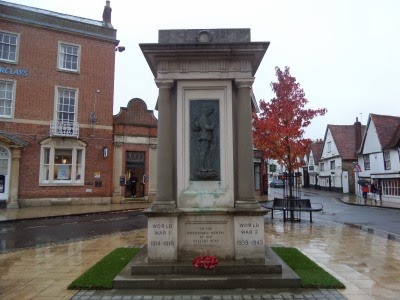
In 1920, the relatives who had lost loved ones in the Great War were canvassed by Abingdon Borough Council’s War Memorial Committee about a fitting memorial. The preferred option was a Statue of a Soldier with 100 votes, a cross got 62 votes, and a monument 31 votes.

The memorial that was decided upon does incorporate a soldier.
On this wet Wednesday, before Remembrance Day, the Royal British Legion wreath remains from last year.
Either side of the monument turf has been placed – for poppies and crosses.
it’s a good idea just to read through the names on it; consider how many names are on it and remember..
The names are listed with their addresses in the roll of honour list, and a copy of this will be found in Abingdon Library
The names are on the AAAHS website http://www.aaahs.org.uk
Given the population of Abingdon at the time of the Great War, I am always humbled by the number of fallen and by the family names that recur.
One of the recruiting strategies for WW1 was to form regiments and the like on localities: “The Accrington Pals” was one example of this. The unforeseen consequence was that huge numbers of casualities were grouped together in streets and villages across Britain. Trench warfare with its Up and Over tactics and fixed machine gun lines added to the massacre. In many villages you will find a war memorial with perhaps a dozen or more names inscribed – nearly half from a couple of families.
In WW2, the recruitment policy was changed (partly because there was general conscription from the beginning), and with greater mechanisation of transport battle strategies changed.
In part, this explains why there are frequently more names on WW1 memorials than WW2. What is often forgotten is that, while on the Western Front (Axis and Allied forces) land battles were never more than about 40 divisions, on the Eastern (front German and Soviet forces) there were frequently battles of 140 divisions (each side!). The slaughter on the Eastern Front of WW2 was comparable to that of WW1 – it’s just that US/British Empire/French forces were not engaged on the Eastern Front.
However, it was all a terrible cost in human life at home and abroad – and we ought to remember that war is vile and those called to fight since WW2 have paid the cost in life and death.
We will remember them.